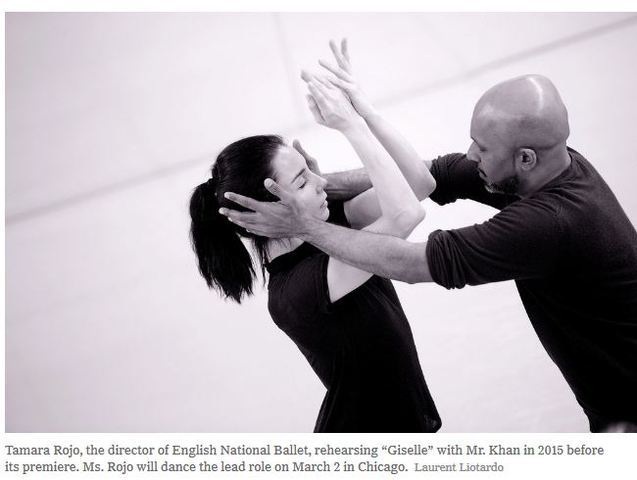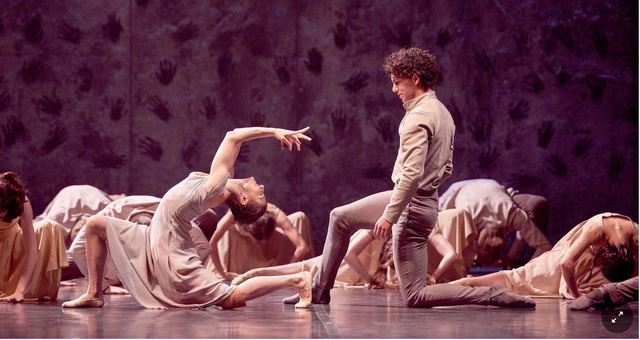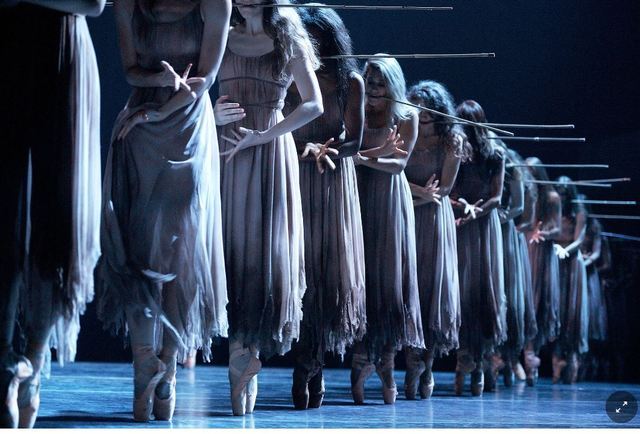


Coming to Chicago: A ‘Giselle’ That Speaks to the Present
By Roslyn Sulcas
Feb. 15, 2019
LONDON — It sounds like an improbable movie pitch: Glamorous ballerina takes over beleaguered ballet company, suffering from budget cuts and a second-string reputation. She hires a contemporary dance choreographer, who has almost no experience working with classically trained performers, to re-envision one of ballet’s most famous and best-loved pieces.
It’s a daring — perhaps foolhardy — decision and she must persuade her board and executive director of its value, and raise the money. Then, a month before the premiere, the composer and choreographer part ways.
Can a new score be written before the premiere? Will the dancers be able to adapt on time?
The director dances the title role, as the ballet opens to rave reviews and rapturous audiences. Her company takes on a new life as a presence on the international scene and an impressive contender on home turf.
This is what happened when Tamara Rojo, the Spanish-born, former Royal Ballet ballerina, decided to commission a new version of the Romantic favorite “Giselle” (1841) for English National Ballet, the company she has run since 2012. As her choreographer, she chose Akram Khan, the British dance maker of Bangladeshi origin who rose to fame here with works that combined classical Indian kathak and contemporary dance techniques.
“Giselle” premiered at the Manchester International Festival in 2016, and on Feb. 28 it will have its United States debut at the Harris Theater in Chicago — English National Ballet’s first North American appearance in 30 years.
Debra Craine, the chief dance critic of The London Times, said Mr. Khan was a surprising choice because he had no history of making ballets. And “English National Ballet doesn’t have the rich patrons that the Royal Ballet has,” she said, “and really has to worry about the budget. To pay for itself, a full-length ballet has to run for years, and that was hardly a sure thing.”
Mr. Khan’s “Giselle,” which blends elements of kathak’s arm and hand work and an earthy rooted physicality with ballet’s graceful lines and soaring jumps, cemented Ms. Rojo’s reputation as a determined, risk-taking presence. It gave English National Ballet a new allure, and brought Mr. Khan’s work to the attention of ballet directors: “The phone hasn’t stopped ringing from ballet companies,” he said.
“Giselle” has already been seen in Hong Kong and New Zealand, and this summer it will travel to the Bolshoi Theater in Moscow. “We could dance nothing but Akram’s ‘Giselle’ for the next few seasons, if we accepted all the requests we have to perform the ballet,” Ms. Rojo said in an interview with Mr. Khan at English National Ballet’s headquarters near the Royal Albert Hall.
One of those requests came from Patricia Barretto, the president and chief executive of the Harris Theater in Chicago, who said that as soon as she heard about the ballet, she was determined to present it. “The ballet couldn’t be more relevant to the cosmopolitan city we live in,” she said in a telephone interview. She added that the cost of bringing the 95-member company for four performances was high, around $1 million: “But we really believed in the importance of bringing this to Chicago.”
What does it mean to re-envision a classical ballet? Why has this one sparked so much interest? Here is a primer on “Giselle,” and edited excerpts from a conversation with Ms. Rojo and Mr. Khan.
The story
“Giselle,” set to a score by Adolphe Adam, is among the earliest of the 19th-century classical ballets that populate the repertory of most big ballet companies. Choreographed by Jean Coralli and Jules Perrot (and later reworked by Marius Petipa) at a time when poets and artists were fascinated by the supernatural, Act I tells the tale of a young peasant woman, Giselle, seduced by Count Albrecht, who has disguised his noble origins. Once his betrayal is revealed, Giselle goes mad and dies of a broken heart. In Act II, she reappears as a Wili — one of the spirits of young woman betrayed by their lovers, whose mission it is to dance any man they encounter to his death. But when Albrecht visits her grave, Giselle defies her destiny to protect him from the Wilis, redeeming his actions through her love.
“Giselle” isn’t an obvious candidate for revision or modernization, partly because it still works so well in its original form, partly because its evocation of the supernatural is so rooted in its time. And the ballet has already had one radical — and very successful — reworking in Mats Ek’s 1982 version, set in a mental hospital.
Why did you think this was a good idea?
TAMARA ROJO I wanted to do a classical ballet from a new point of view, and I wanted the hardest one, the unquestionable one: “Giselle.” I had seen the Bjork film “Dancer in the Dark,” and I kept thinking: This is Giselle, and it is possible to tell this story in a new context. And it can be just as heartbreaking and disturbing, perhaps more, because I can relate to it. I had commissioned Akram to do “Dust,” a short work for the first mixed bill I did as director; knowing the spirituality of his work, his talent for narrative, I thought he would be the perfect person to take it on.
AKRAM KHAN When Tamara asked me, I did think a bit: Are you mad? I had barely seen a ballet, and knew nothing about “Giselle.” I watched it on a DVD, then watched Mats Ek’s version, which really blew me away. Then I thought, I really don’t want to do this!
But I realized that the second act was about spirituality and love, and with Ruth Little, my dramaturg, I thought: How can we see “Giselle” now? We were upset and frustrated by the immigration crisis, and there was an incident in Bangladesh in which a factory collapsed and killed many people. Both were in my mind, and both elements found their way into the ballet.
Building the wall
Mr. Khan’s “Giselle,” designed by Tim Yip (“Crouching Tiger, Hidden Dragon”), is set beneath a vast, pitted and scarred wall, which separates the migrant garment factory workers from the wealthy “landlords” who have closed the factory, leaving the workers destitute in a makeshift camp, waiting for work and rescue. The parallels with today’s political preoccupations — whether in the United States or Brexit-era Britain — are striking.
How far can you take a work away from its original form and content without changing its essence?
KHAN That was a question we asked ourselves. We decided that as long as we had love, forgiveness and betrayal, it was still “Giselle.” Act I was harder to rethink than Act II, which is about life and death, spirituality, the ethereal, themes that come more naturally to me. In Act I, the people onstage had to feel relevant to me. Who are they? What do they represent? Tamara and I talked a lot about that.
For me, ballet, and for that matter kathak, the classical Indian dance form that I trained in, don’t belong to a particular era. I wanted to make a piece that was also about what is happening to us right now, although I wasn’t thinking about Brexit or anything specific when we were making it.
ROJO I think when you have been inside an art form for a long time, you can lose perspective on what is interesting, what you can relate to. When you read the reviews of the first performances of “Giselle,” you understand that the Wilis were really scary. Now we think of if as a “pretty” ballet, and it has lost some of that impact, which I think is brought back through this context of poverty and migration that Akram gives to the ballet.
I don’t think we can keep things frozen in time and sacrosanct. I understand the protective feeling that many of us in the ballet world have about the classics. They are so fragile, passed down almost through Chinese whispers, and we want to cling to them. But if there is one thing I have learned living in Britain and going to the theater, is that you should challenge the classics. They deserve to be alive, to have great minds have a go at them.
Why this ‘Giselle’ has resonated
“You can’t ignore its emotional power,” Ms. Craine said, adding that audiences respond to its “poetic meditation on the themes of the original, filtered through the experience of refugees and displaced people.”
What next? Will Ms. Rojo program more story ballets? Will Mr. Khan take on any other ballet classics?
“We have a new project,” Ms. Rojo said cautiously. “We’ll tell you soon.”
https://www.nytimes.com/2019/02/15/arts ... ctionfront